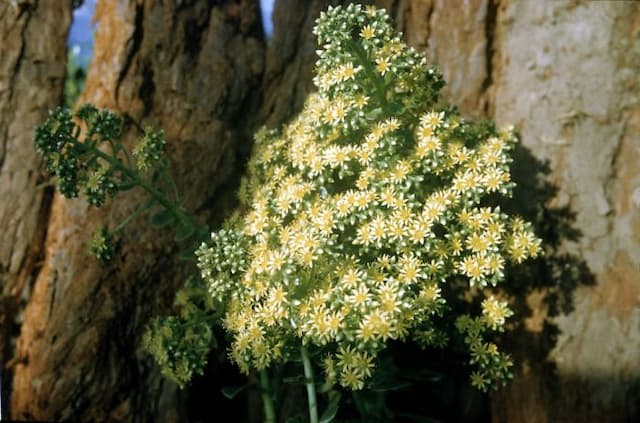Molded Wax Agave Echeveria agavoides 'Taurus'
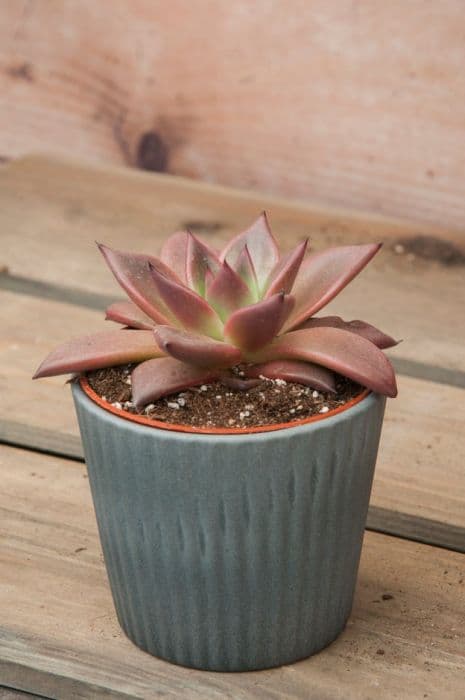
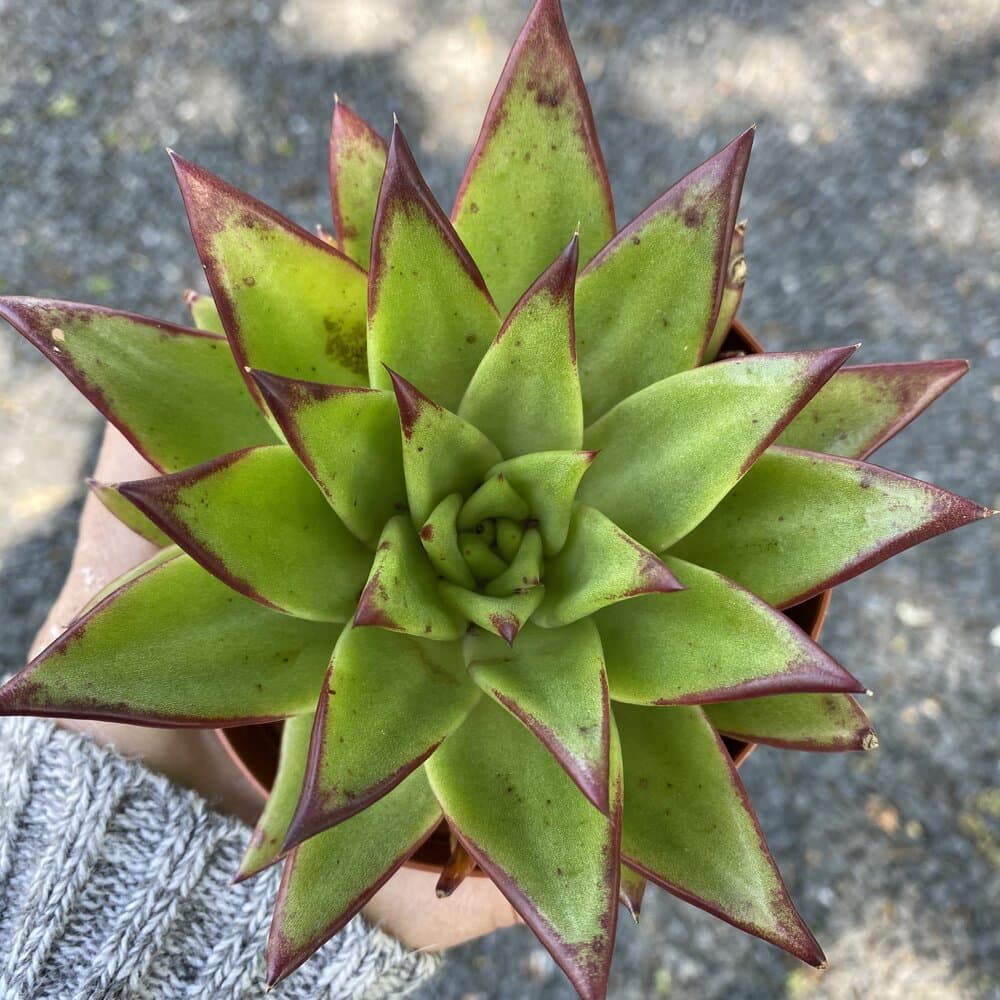
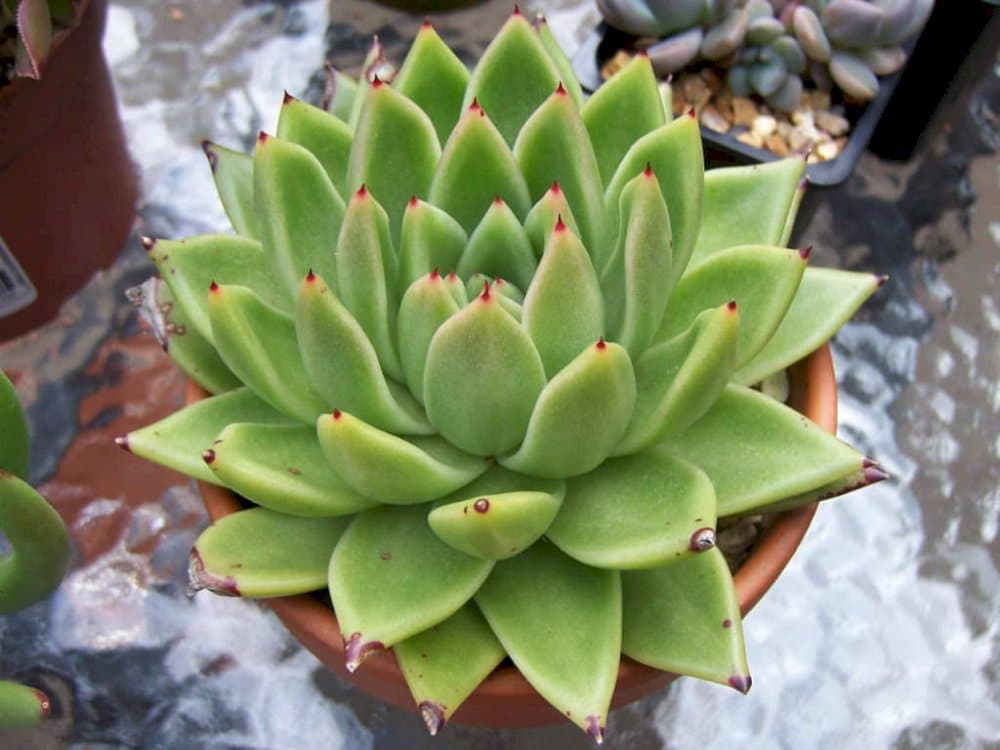
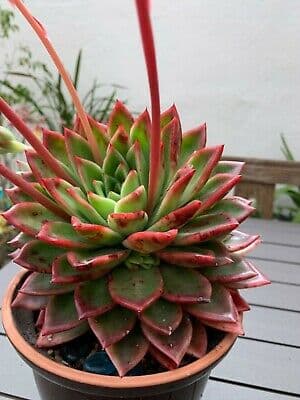
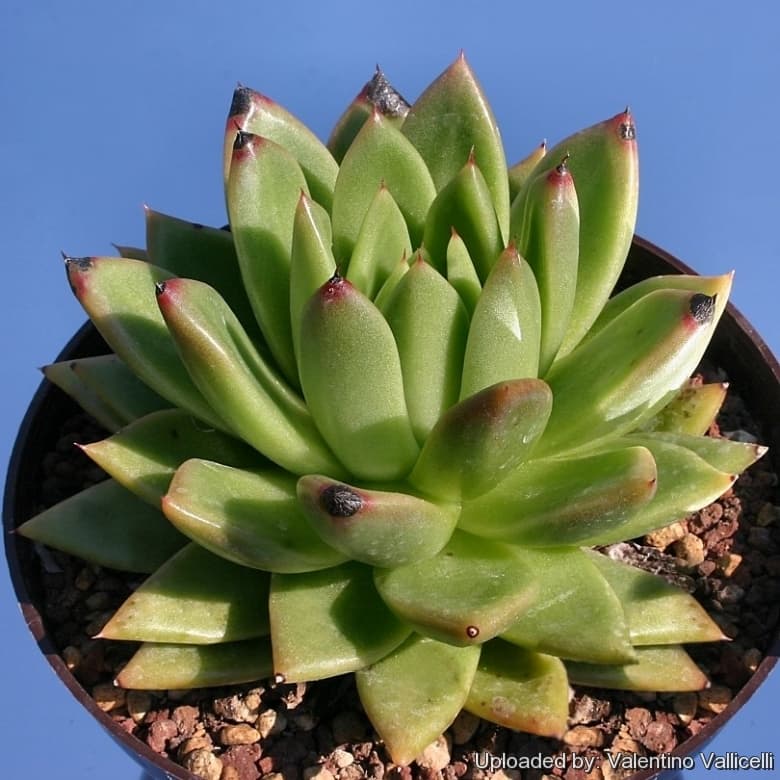
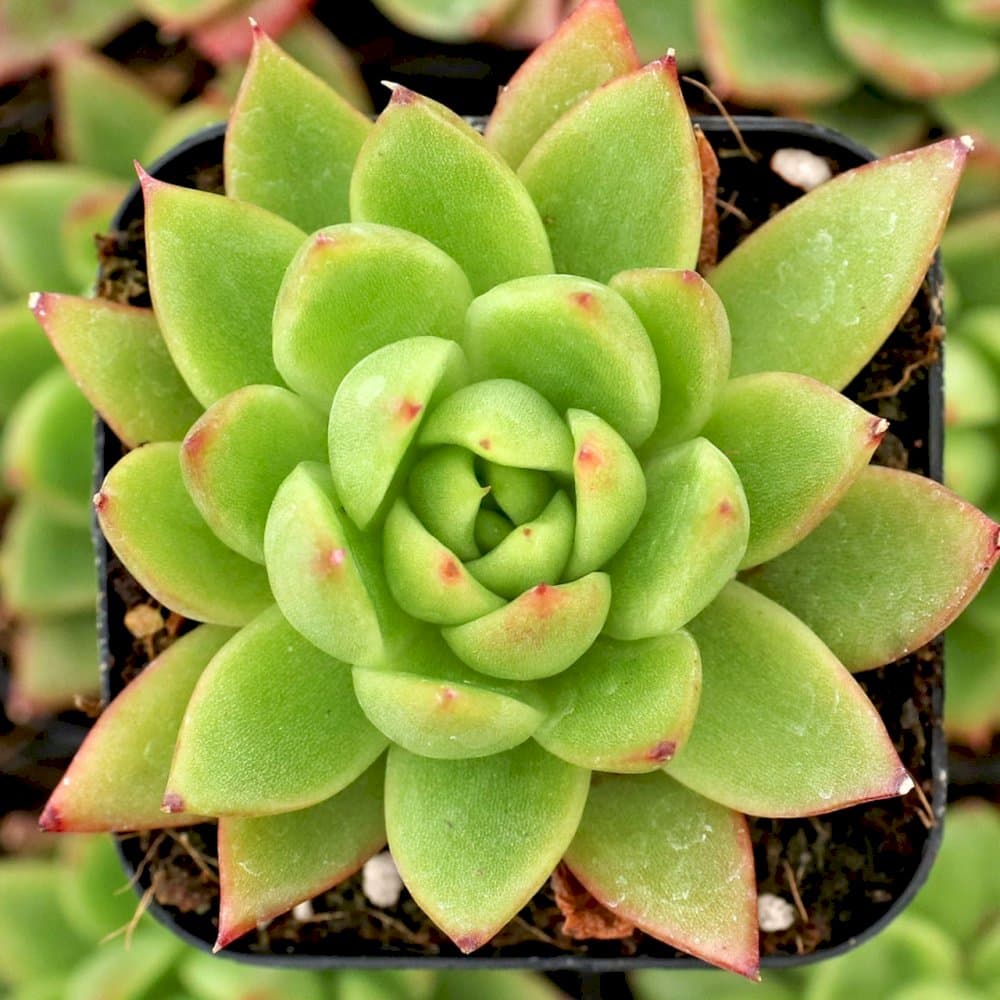
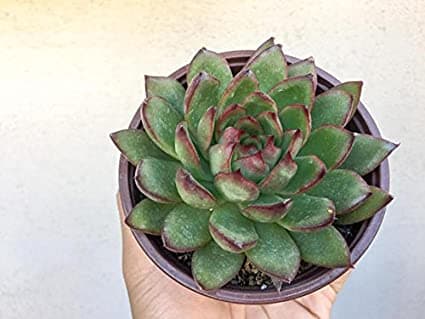
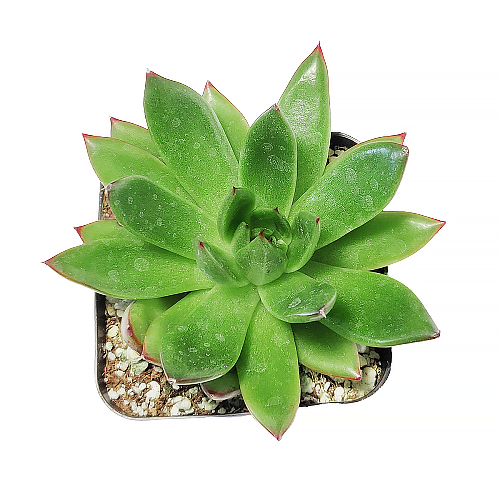

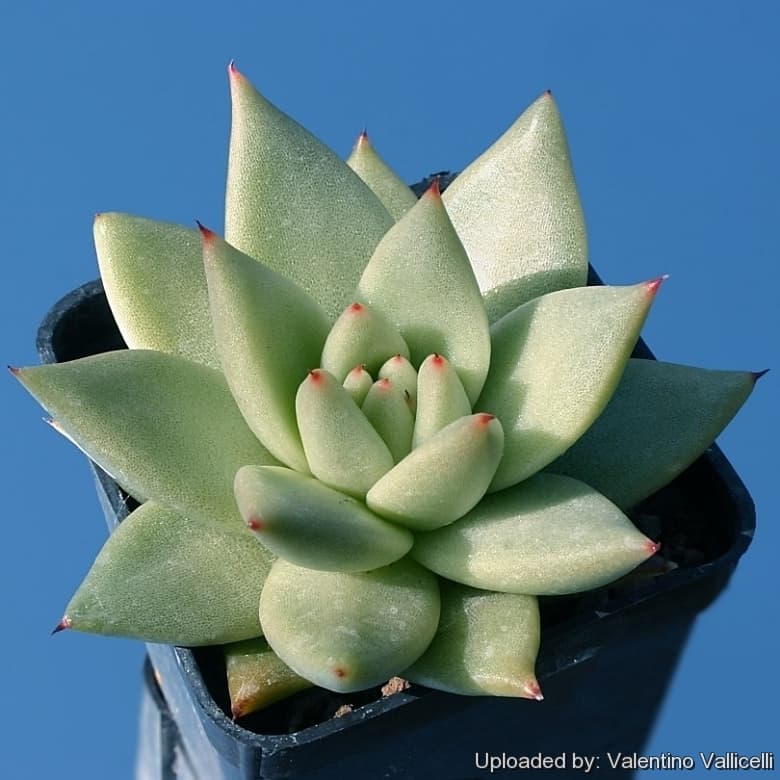
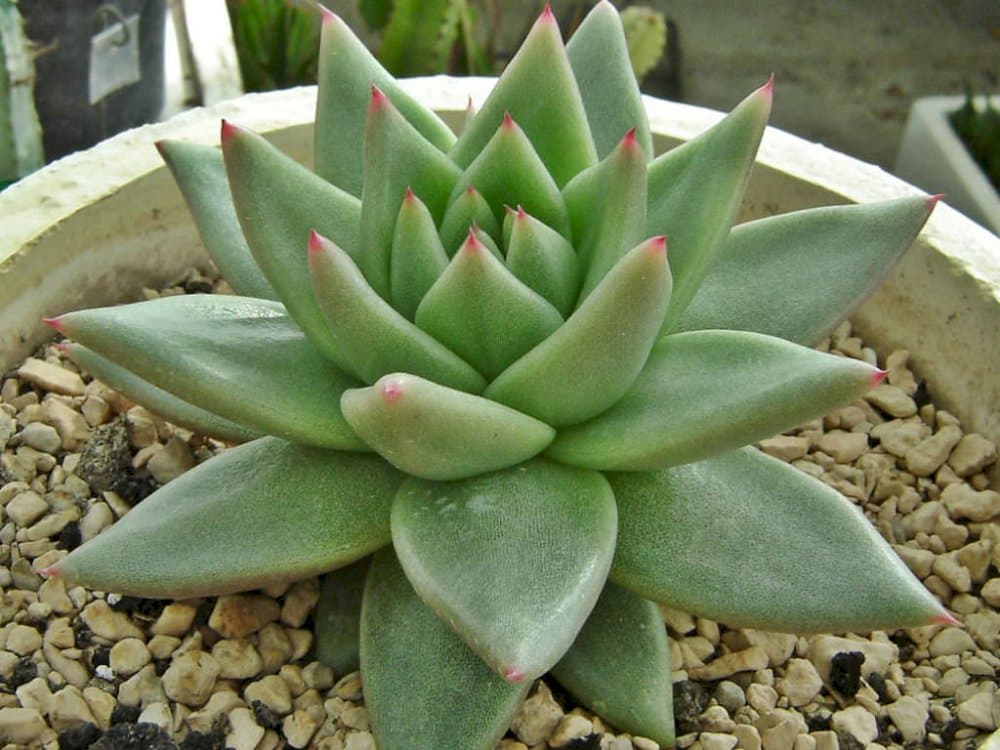
ABOUT
The Echeveria agavoides 'Taurus', commonly known as the Taurus Echeveria, is a succulent plant characterized by its rosette formation. It has thick, fleshy leaves that are distinctively pointed, resembling an agave, a feature that influences its name. The leaves are a vibrant green to deep red, especially pronounced at the tips, appearing as if they have been dipped in paint. These color changes can be more intense when the plant is exposed to bright light. The leaves are also marked with slight ridges, giving them added texture and interest. The Taurus Echeveria typically blooms in the warmer months, producing flower stalks that carry bell-shaped flowers. The flowers are often a pinkish-red with yellow tips, adding to the plant's ornamental appeal. The plant's overall aesthetic is one of bold geometry and color contrast, making it a popular choice for succulent arrangements, rock gardens, and as a container specimen. Its robust appearance and coloration make it a stunning visual feature in any succulent collection.
About this plant
 Names
NamesFamily
Crassulaceae
Synonyms
Molded Wax Agave, Taurus Echeveria, Lipstick Echeveria
Common names
Echeveria agavoides 'Taurus'.
 Toxicity
ToxicityTo humans
Echeveria agavoides, commonly known as wax agave, is not considered toxic to humans. If ingested, it generally does not cause any symptoms of poisoning, and consequently, there are no notable toxic effects known from ingestion of this plant.
To pets
Wax agave is also not considered toxic to pets. It is generally safe around animals, and there are no known toxic effects or symptoms of poisoning associated with pets ingesting any parts of this succulent plant.
 Characteristics
CharacteristicsLife cycle
Perennials
Foliage type
Evergreen
Color of leaves
Green
Flower color
Red
Height
6 inches (15 cm)
Spread
6 inches (15 cm)
Plant type
Succulent
Hardiness zones
9
Native area
Mexico
Benefits
 General Benefits
General Benefits- Low Maintenance: Echeveria agavoides 'Taurus', commonly known as the 'Taurus' echeveria, requires minimal care once established, making it ideal for beginner gardeners or those with busy lifestyles.
- Drought Tolerant: This succulent has adapted to survive in dry conditions, conserving water in its leaves, which allows it to thrive even during periods of infrequent watering.
- Attractive Aesthetic: With its striking rosettes and red-tipped leaves, Taurus echeveria is a visually appealing plant that enhances the aesthetic of any setting, whether indoors or outdoors.
- Minimal Space Requirements: As a compact plant, it is suitable for small spaces such as windowsills, terraces, and miniature gardens, making it a versatile choice for various living environments.
- Year-Round Interest: Taurus echeveria remains evergreen throughout the year, providing consistent visual interest regardless of the season.
- Propagation Ease: This plant is easily propagated from leaf cuttings or offsets, allowing gardeners to expand their collection or share with friends and family.
- Non-Toxic to Pets: Taurus echeveria is generally considered safe and non-toxic, making it a pet-friendly choice for households with animals.
- Resistant to Pests: It has a natural resistance to common pests, reducing the need for chemical treatments and fostering a healthier growing environment.
 Medical Properties
Medical PropertiesThis plant is not used for medical purposes.
 Air-purifying Qualities
Air-purifying QualitiesThis plant is not specifically known for air purifying qualities.
 Other Uses
Other Uses- Photography Prop: Echeveria agavoides 'Taurus', commonly known as Lipstick Echeveria, makes for a visually appealing subject in close-up and macro photography, often highlighting the plant's vibrant red tips and rosette shape.
- Educational Tool: Lipstick Echeveria can be used to educate students and plant hobbyists about succulent care, propagation techniques, and the diversity of plant forms in nature.
- Artistic Inspiration: The symmetrical form and striking coloration of Lipstick Echeveria provide a natural template for artists and designers seeking inspiration for patterns, textures, and color palettes.
- Wedding Favor: These succulents can be potted in small containers and given as eco-friendly and long-lasting wedding favors to guests.
- Jewelry Displays: Lipstick Echeveria can be used in jewelry stores or at craft fairs as an organic display element to showcase rings and small accessories.
- Themed Parties: For garden-themed or nature-inspired events, Lipstick Echeveria can be used as part of the table centerpieces or decorations to create a cohesive aesthetic.
- Crafting: The rosettes of Lipstick Echeveria can be detached and used in crafting, such as in making living wreaths or as embellishments in floral arrangements.
- Meditative Object: The structured, yet organic shape of the Lipstick Echeveria can serve as a calming focal point for meditation and relaxation practices.
- Collector's Item: Particularly for rare or vibrantly colored cultivars, Lipstick Echeveria can be collected and treasured by succulent enthusiasts for their unique characteristics.
- Green Roofing: When planted en masse, Lipstick Echeveria can be used in green roofing projects to provide not only aesthetic value but also to contribute to the insulation and absorption of rainwater.
Interesting Facts
 Feng Shui
Feng ShuiEcheveria is not used in Feng Shui practice.
 Zodiac Sign Compitability
Zodiac Sign CompitabilityEcheveria is not used in astrology practice.
 Plant Symbolism
Plant Symbolism- Persistence: Echeveria agavoides 'Taurus', commonly known as Wax Agave, typically symbolizes persistence because of its ability to thrive in arid conditions and retain water for long periods.
- Resilience: The Wax Agave is highly resilient to drought, reflecting an attribute of bouncing back from challenges and adversity.
- Beauty and Balance: With its rosette pattern and symmetry, the Wax Agave represents beauty and balance in nature, often relating to the aesthetic harmony in one’s life.
- Enduring Love: Due to its long-lasting nature and the heartiness of the succulent, it can symbolize an enduring and persistent love.
 Water
WaterThe Lipstick Echeveria should be watered thoroughly when the soil is completely dry, which typically means every seven to ten days during active growth in warmer seasons, but only once a month during its dormant period in winter. The amount of water should be enough to soak the soil without causing standing water, which can lead to root rot. As a guide, provide about 8 to 12 ounces of water for a small to medium-sized pot every watering session. It's crucial to avoid getting water on the rosettes to prevent rot.
 Light
LightLipstick Echeveria requires bright light with some partial sun to maintain its vibrant colors and tight rosette form. A spot near a south or west-facing window that receives plenty of indirect sunlight with some direct rays in the morning or late afternoon is ideal. Avoid intense, direct sunlight in peak summer, which can scorch the leaves.
 Temperature
TemperatureLipstick Echeveria prefers a temperature range of 65 to 80 degrees Fahrenheit during the day and should not be exposed to temperatures below 50 degrees Fahrenheit to avoid cold damage. The ideal temperature for this succulent is around 70 degrees Fahrenheit. Providing adequate temperature conditions is important for the health and vibrancy of the plant.
 Pruning
PruningPruning the Lipstick Echeveria is generally done to remove any dead or damaged leaves and to maintain its neat, compact appearance. Prune sparingly and only when necessary, typically once a year in early spring. Using sterile, sharp scissors, carefully snip away any undesired foliage. The best time for pruning is when the plant is coming out of dormancy and beginning to show new growth.
 Cleaning
CleaningAs needed
 Soil
SoilLipstick Echeveria thrives in a well-draining soil mix consisting of one part potting soil, one part coarse sand, and one part perlite or pumice. The ideal soil pH for this succulent is around 6.0 to 6.5, slightly acidic to neutral.
 Repotting
RepottingLipstick Echeveria should be repotted every two to three years to ensure fresh soil and room for growth. Choose a pot only slightly larger than the current one.
 Humidity & Misting
Humidity & MistingLipstick Echeveria prefers low to average humidity levels, typical of arid environments, and will thrive in the typical indoor humidity conditions found in most homes.
 Suitable locations
Suitable locationsIndoor
Bright light, minimal water, well-draining soil, and occasional fertilizing.
Outdoor
Full to partial sun, dry conditions, and well-draining soil mix.
Hardiness zone
9-11 USDA.
 Life cycle
Life cycleEcheveria agavoides 'Taurus', commonly known as Taurus Echeveria, begins its life cycle as a seed, germinating in warm, well-draining soil with plenty of indirect sunlight. The seedling stage follows, characterized by the development of primary leaves as the plant establishes roots and begins photosynthesis. Following the juvenile stage, the Taurus Echeveria enters a phase of vegetative growth where it forms its distinctive rosette shape and thick, waxy leaves that are a deep green to reddish color depending on sun exposure. During its mature stage, the plant may produce offsets, also known as "pups," around its base, which can be detached to propagate new plants. The Taurus Echeveria blooms in the mature to the late mature stage, sending up tall flower stalks with bell-shaped flowers that attract pollinators. The adult plant may continue to live for many years, producing new offsets and flowering seasonally until it eventually succumbs to old age or environmental stresses.
 Propogation
PropogationPropogation time
Spring-Summer
The most popular method to propagate the Echeveria agavoides 'Taurus', commonly known as the Echeveria 'Taurus', is through leaf cuttings. This technique is ideally done in the warmer months of spring or summer when the plant is actively growing. To propagate, a healthy, plump leaf is gently twisted off the stem, making sure the entire leaf is removed without tearing. Once removed, the leaf should be left to callous over for a few days in a dry, warm place away from direct sunlight. After the cut end has formed a callous, the leaf can be placed on top of a well-draining cactus or succulent potting mix. The leaf should be kept in bright, indirect light and only lightly watered when the soil is completely dry to avoid rot. In time, a new rosette will begin to form at the base of the leaf, and roots will develop. Once the rosette has grown and the original leaf has withered, the new plant can be potted on its own.
